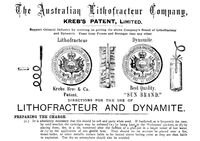


Chapter 9
I Introduction
II The Australian Chemical Industry
i Beginnings 1865-1919
ii Fertilisers
iii Raw materials from gasworks and coke ovens
iv The beginnings of industrial chemical research - in the sugar industry
v Explosives
III Pharmaceuticals
IV Chemists In Other Industries
V The Dawn Of Modern Chemical Industry - High Pressure Synthesis
VI The Growth Of Synthetic Chemicals - Concentration, Rationalisation And International Links
VII Australian Industrial Chemical Research Laboratories
VIII The Plastics Industry
IX The Paint Industry
X Acknowledgements
References
Index
Search
Help
Contact us

Nobel organised his production by licences in two centres, the Anglo-German dynamite makers in Glasgow and the Latin producers in France.[31][32] However, in Britain both dynamite and gelignite met with considerable resistance from the authorities.[33] Manufacture there started some seven years later than in Germany. It was perhaps due to this delay in the Empire that an enterprising and apparently somewhat sharp German industrialist and epigone of Nobel's, one Friedrich Krebs of Krebs Bros. & Co., Cologne, established very early, probably around 1873/74, importation into Australia of 'Lithofracteur', a dynamite variant. Krebs had patented this, presumably on the basis of some additives to the Nobel recipe, but was sued for infringement by the British Dynamite Company, who took him as far as the House of Lords and eventually, four years later (1879), won a resounding victory. The enterprising Krebs, however, undaunted by the injunction in the U.K., sought refuge for his product not only in the prolonged entanglements of patent law in Britain, but also in geographic distance. Perhaps he was aware that Nobel had filed in Australia very late (1872); perhaps he was guided by the old European saying -the Czar is far away and the Lord is high above -in any case he cheerfully infringed or evaded the Nobel patents in Australia, imported and in 1874, but one year after the start up of the Scottish factory began to manufacture in Australia (Fig. 4). There are very few later parallels in Australia's technological history where a fundamental invention of world-wide importance was reduced to technical and commercial practice in Australia within one year from its emergence in the Anglo-Saxon world. Krebs' commercial judgement, if not his business ethics, deserve respect. The Australian market turned out to be one of the most important in the nineteenth century, an almost incredible feat in the face of a population just approaching two million in 1876.[34] Krebs' manufacture never gained more than a small, essentially regional market share against the technical superiority of the Nobel Group.

The rapid development over a few decades of goldming in Victoria and other mines far away from Deer Park -precious and base metals in Queensland, gold in Kalgoorlie and lead, zinc and silver in Broken Hill -was more than Deer Park could cope with, technically and financially. The speed with which Australians adopted and adapted the new technology is indicated by the export figures of Nobel's Explosives Company Ltd.: In 1878, 144,200 Ibs., 14 per cent of UK market, over 50 per cent of total exports; in 1883, 506,540 Ibs., 45 per cent of UK market, over 50 per cent of sales in the British Empire.[35] However, Victorian policy aimed at support of local manufacture imposed a significant duty on dynamite. Krebs' agent in Victoria, Robert Steel Scott and Krebs' London partner Thomas Tolley Jones, therefore negotiated a licence from Krebs and founded a £30,000 company, Australian Lithofracteur Company (Krebs Patent) Ltd. After 1888, it changed its name and was registered in London as the Australian Explosives and Chemical Company Ltd. This then, and not Nobel established the first manufacture of dynamite 'Lithofracteur' in Australia. The chosen site was Kororoit Creek, later called Deer Park, a long way outside Melbourne suburbs and at the time a safe distance from housing. Only nitrate and sulphur had to be imported; sulphuric acid, glycerol and kieselgur were already available locally. Timber huts and sheds, safely separated and surrounded with mounds were built (Fig. 5), a few experienced German operators imported and manufacture was commenced either in 1874 by Jones Scott & Co., or in 1875 by Australian Lithofracteur.[36]

Organisations in Australian Science at Work - Australian Explosives and Chemical Company Ltd; Australian Lithofracture Company (Krebs Patent) Ltd; Jones Scott & Co.; Nobel's Explosives Company Ltd
People in Bright Sparcs - Krebs, Friedrich; Scott, Robert Steel
 |
Australian Academy of Technological Sciences and Engineering |  |
© 1988 Print Edition page 640, Online Edition 2000
Published by Australian Science and Technology Heritage Centre, using the Web Academic Resource Publisher
http://www.austehc.unimelb.edu.au/tia/609.html